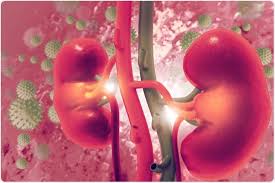
Azotemia, a metabolic disorder characterized by an increase in nitrogenous waste products (BUN—usually ranging from 7 to 21 mg/dL), creatinine in the blood, and various secondary waste products throughout the body.
Table of Contents
What happens in azotemia?
It is a condition that occurs when your kidneys have been damaged by disease or an injury. You get it when your kidneys are no longer able to get rid of enough nitrogen waste. It usually diagnosed by using urine and blood tests. These tests will check your blood urea nitrogen (BUN) and creatinine levels
What is human azotemia?
It characterised by a rise in BUN and serum creatinine levels. BUN has a reference range of 8-20 mg/dL. Serum creatinine reference ranges differ significantly depending on age and gender: in adults, the normal range is 0.5-1.1 mg/dL (44-97 mol/L) for women and 0.6-1.2 mg/dL (53-106 mol/L) for men.
Is azotemia the same as renal failure?
An overabundance of nitrogen compounds in the blood is known as azotemia. Uremia, also known as uremic syndrome, occurs when your body’s nitrogen levels grow too high. If left untreated, azotemia can cause acute (sudden) renal failure. Renal failure occurs when each kidney fails.
Symptoms of Azotemia.
It is a prevalent health problem among the elderly and hospitalised patients. Approximately 8% to 16% of hospital admissions are due to azotemia. When your kidneys injured by injury, disease, or drugs, they are unable to eliminate enough nitrogen waste from your body.
The symptoms may include:
- Loss of appetite.
- Acute Renal Failure.
- Acute kidney injury.
- Nausea and vomiting.
- Loss of energy.
- Not agreeness in participate in daily usual activities.
- Fluid retention.
Types of Azotemia
There are three types:
- Prerenal
- Intrinsic
- Postrenal
Causes
The primary cause is a loss of kidney function. However, there are different types , which may arise from or be a part of renal failure, have different causes:
- When fluid flowing through the kidneys isn’t enough to remove the nitrogen (prerenal).
- When the urinary tract is obstructed by something or by a rupture (postrenal ).
- Infection or disease or intrinsic.
- Lowered blood volume.
- Heart failure.
- Injury to the kidney.
- Complication in diabetes disease.
- Some medications, particularly nephrotoxic drugs and high doses of steroids.
- Advanced age.
- History of renal difficulties.
- Heat exposure.
- Severe burns.
- Dehydration.
- Some surgeries.
Cancer treatment can also sometimes cause azotemia. Chemotherapy drugs are powerful and can damage your kidneys. They can also cause a significant quantity of nitrogen-containing byproducts to be released by the dying cancer cells.
Your oncologist will monitor your kidneys and ammonia level with regular tests. If needed, your doctor may be able to adjust or try different chemotherapy medications if your kidneys are affected.
How it is treated?
The treatment of azotemia depends on the type, cause, and what stage of progression it’s in. With this in mind, some of the treatments may include:
- Dialysis.
- Changes to healthy eating habits.
- Intravenous fluids.
- Delivery of the baby in the case of pregnancy.
- Early treatment of post-renal-azotemia.
- Treatment of the underlying condition or disease.
- Proper medications.




